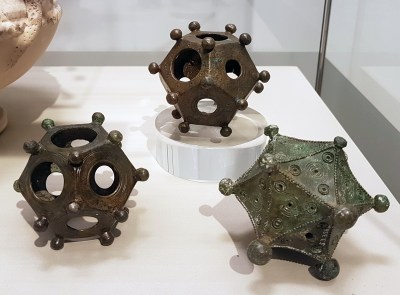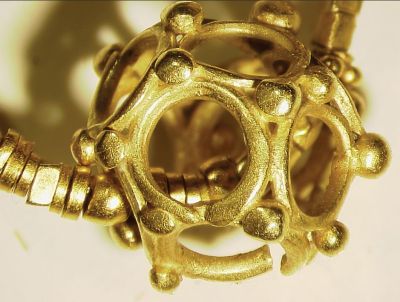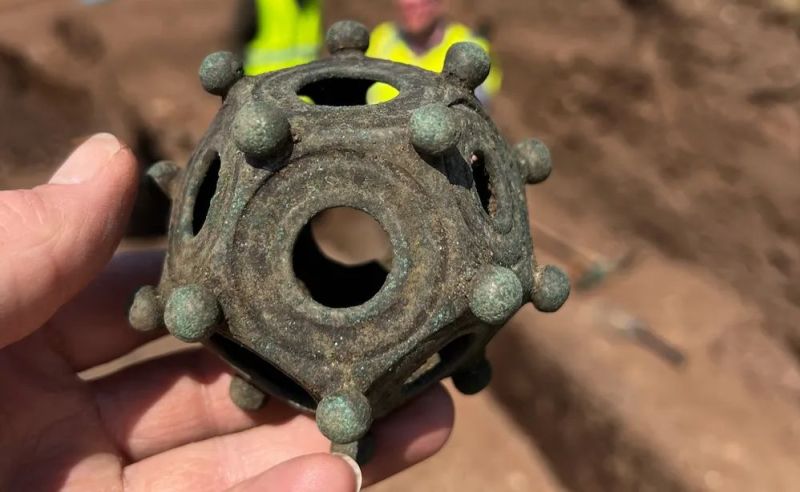Much about archaeology can be described as trying to figure out the context in which objects and constructions should be interpreted. A good example of this are the metal dodecahedrons (twelve-sided shape) which have been found during archaeological excavations at former Roman sites. Since 1739 over 115 of them have been recorded, most recently a fully intact copper specimen found near the Lincolnshire village of Norton Disney during the Summer of 2023 by a local group of archaeologists.

As the Norton Disney History and Archaeology Group notes on their page, this is the 33rd example of one of these items found in what was once Roman Britain, lending credence to the idea that such dodecahedrons originated within the Gallo-Roman culture.
As for the objects themselves, the ones so far found were dated to between the 2nd and 4th century CE, are all made out of some kind of metal alloy (e.g. bronze), are usually a dodecahedron but sometimes different (e.g. an icosahedron with 20 faces), yet all are hollow and usually with a single large hole in each face. The dodecahedron found at Norton Disney was analyzed to consist out of 75% copper, 7% tin and 18% lead, with a width of 8.6 cm and weighing in at 254 grams.
What is perhaps most interesting about these objects is that they can be found all across the former Roman Empire, as well as the Maritime Silk Road with similar examples found in what today is Óc Eo in Vietnam, but which used to be part of the Kingdom of Funan, as well as in Myanmar (formerly Burma). These finds generally are in the form of smaller, golden polyhedrons, albeit possessing a strong resemblance to the versions found throughout the former Roman Empire. A great overview of these Asian versions is provided by Anna T. N. Bennett in a 2009 article in Archeo Sciences.

As for the purpose of those objects, it is clear that at least the golden type was intended as decorative jewelry, possibly with some religious overtones. The ones made out of bronze and similar materials are more of a mystery, with a variety of uses suggested over the years, including as a spool knitting device, as well as a mathematical or a surveying instrument, yet none of the available sources from the era ever reference these objects, making that highly unlikely.
Ultimately it is highly likely that these objects were made and coveted primarily because people liked how they looked, which isn’t too dissimilar from how humans today pick and choose baubles to keep around, whether on shelves or as part of personal jewelry.
Some of us also like to build LED-covered dodecahedrons for fun, which is something that will have archaeologists in a few hundred years from now likely very puzzled. You can also assemble your own Gallo-Roman-style dodecahedron if you really want to throw said archaeologists for a loop.















The dodecahedrons are the Roman equivalents of Fisher Price toys. Mystery solved.
Look at my website romandodecahedron.com
The functioning of the dodecahedron as a measuring device is based on the angle of the sun on the highest point of the day. The dates that can be measured were probably of importance for the agriculture. The sowing date of winter grain is important for the achievement of optimal produce. Therefore I anticipate that the dodecahedron would only be used in autumn time.
My hypotheses explains also the small differences in the openings of the dodecahedron of Elst, this dodecahedron is not symmetrical, and also the function of the Roman icosahedron.
Regarding the sowing date, it is also possible that with the dodecahedron and icosahedron the Celtic new year was recorded. In my opinion, this date was not November 1 but was linked to the optimal sowing date for winter grain and is therefore different in every agriculture region. See also my articles on my website about the calendar and the meaning of Halloween.
This could also explain why the function of the dodecahedrons was not described by the Romans.
Maybe for horse therapy massager to fix muscles.
Maybe something similar to an secret communication tool : early version of an “enigma” machine
The Roman scytale?
https://en.m.wikipedia.org/wiki/Scytale
A gage to measure the diameter of poles or rods.
It’s a military surveying device used for establishing a military marching camp in the geometry of the golden rectangle using the golden ratio derived from the object. It is well known that the Roman military camps are rectangular in shape and the two length sides of the rectangle exhibit the golden ratio very approximate. The holes were picked by a ranking officer to establish the size of the camp (large or small). A typical size Roman soldier would mark off from the user of the device such that he would be totally inscribed by the circumference of the hole ( no standard other than a typical sized soldier was needed to establish an approximate camp size ). The nibs would have twine wrapped and using the geometry of the pentagon a golden ratio was established for the encampment. This gave the encampment a cosmological space and power of authority outside of imperial Rome. These objects would have been forbidden in Rome since they were of a military purpose.
A fairly convincing demo of using a Roman dodecahedron to knit gold chains and yarn cords can be found at https://www.youtube.com/watch?v=lADTLozKm0I
My theory is it’s used to draw lengths of coppice though, and brambles to take off the lumps, bumps and thorns for basket making… Made in the foundry as a test of skill but has a very useful function too…